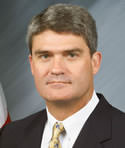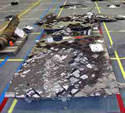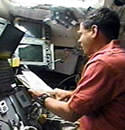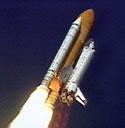NASA now believes they could have launched the space shuttle Atlantis and four veteran astronauts to rescue the crew of Columbia had they realized the danger earlier. In the days after the February 1 tragedy, NASA said there was nothing that could have been done to fix Columbia’s wing, but the shuttle investigation board asked the agency to figure out what they could have done if they had known about the damage. Columbia’s 16 days of supplies could have been stretched to 30 to give time to mount a rescue mission.
Foam Does Seem to Be the Culprit in the Columbia Disaster
Investigators said today that they believe chunks of foam have torn off shuttle fuel tanks in the past, and that this is still the mostly likely cause of the destruction of Columbia. By analyzing launch videos, the investigators found instances in six previous flights where foam peeled off the tanks and struck the shuttle. The group?s final report is expected to be delivered later this summer, and is expected to include recommendations for NASA?s management practices, safety programs and culture.
NASA Selects New Shuttle Program Manager

Image credit: NASA
NASA announced on Friday that William Parsons will become the new manager for the space shuttle program, replacing Ronald Dittemore who resigned on April 23. Previous to this position, Parsons was the director for NASA?s John C. Stennis Space Center in Mississippi. Dittemore had made plans to leave the position long before the Columbia disaster, but decided to stay on longer to help coordinate the investigation.
NASA today announced the selection of William (Bill) W. Parsons as the new manager for the Space Shuttle Program. Parsons, the director of the NASA John C. Stennis Space Center (SSC) in south Mississippi, succeeds Ronald D. Dittemore, who announced his resignation April 23.
“Bill is a talented leader, motivator, and he’s deeply devoted to the success of the Space Shuttle program,” said William F. Readdy, Associate Administrator of Space Flight at NASA Headquarters in Washington. “His management, technical experience, and dedication to safety are vital as we move forward and prepare to start flying again.”
Parsons has served as Center Director since August 2002. He was first assigned to SSC in 1997 as the Chief of Operations of the Propulsion Test Directorate. Parsons relocated to NASA Johnson Space Center (JSC) in Houston to become the Director of the Center Operations Directorate, and he later served as the Deputy Director of JSC. He returned to SSC in 2001, and he served as Director of the Center Operations and Support Directorate.
“I welcome the opportunity to work with Bill. He knows the space flight family and he knows the Space Shuttle program,” said Michael C. Kostelnik, Deputy Administrator for the International Space Station and Space Shuttle programs at Headquarters in Washington. “NASA is about the people who fly, fix, maintain and design our vehicles, and I know we’ve found a terrific leader to help guide the team through this difficult time.”
“This is a critical position for the agency as we begin to focus our Return to Flight efforts in the wake of the Columbia tragedy,” said NASA Administrator Sean O’Keefe. “The Space Shuttle Program, the entire space flight community, and the nation will be served by Bill’s great leadership. He will be missed by our colleagues at Stennis, but the benefits to all the NASA family will be tremendous.” Parsons began his career in the United States Marine Corps as an Infantry Officer, then worked as a manufacturing engineer and later as an aerospace engineer at Cape Canaveral Air Force Station in Florida.
In 1990, Parsons joined the NASA team at Kennedy Space Center (KSC) as a Launch Site Support Manager in the Shuttle Operations Directorate, worked as an Executive Management Intern, and later as the Shuttle Flow Director of the Shuttle Operations Directorate at KSC. In 1996, he became Manager of the Space Station Hardware Integration Office at KSC.
“From the first time I saw a Space Shuttle launch, I knew I wanted to be a part of NASA and America’s space exploration efforts,” said Parsons. “This is a challenging time for the program, but the people of NASA have a long, successful history of overcoming adversity. I’m proud to be a part of the Return to Flight effort and look forward to getting the Space Shuttle safely flying again.”
Parsons has received numerous honors, including NASA’s Exceptional Service Medal; the National Intelligence Medal of Achievement; the Silver Snoopy, awarded by astronauts for outstanding performance in flight safety and mission success; the Center Directors’ Commendation; and the Commandants Certificate of Commendation from the United States Marine Corps.
He graduated from the University of Mississippi with a Bachelor of Engineering degree. He also holds a Master of Science degree in Engineering Management from the University of Central Florida.
Stennis Deputy Director Michael Rudolphi will serve as interim director until a permanent successor is named.
Original Source: NASA News Release
Columbia Investigators Release Preliminary Report

Image credit: NASA
The Columbia Accident Investigation Board, the group attempting to determine what destroyed the space shuttle Columbia in February, released some preliminary recommendations for NASA to prevent future shuttle accidents. They recommended increased inspections of several shuttle components as well as taking images of the shuttles while they’re in orbit by various space-based cameras to detect any damage.
Houston, Texas — The Columbia Accident Investigation Board today issued two preliminary recommendations to NASA. Additionally, the Board issued several facts regarding the shuttle program.
Recommendation One: Prior to return to flight, NASA should develop and implement a comprehensive inspection plan to determine the structural integrity of all Reinforce Carbon-Carbon (RCC) system components. This inspection plan should take advantage of advanced non-destructive inspection technology.
This recommendation was issued because of the board’s finding that current inspection techniques are not adequate to assess structural integrity of RCC, supporting structure, and attaching hardware.
Recommendation Two: Prior to return to flight, NASA should modify its Memorandum of Agreement with National Imagery and Mapping Agency (NIMA) to make on-orbit imaging for each Shuttle flight a standard requirement.
This recommendation was issued because of the board’s finding that the full capabilities of the United States Government to image the Shuttle on orbit were not utilized.
Facts Regarding RCC Components — The board will include the following facts in its final report:
* The Reinforced Carbon-Carbon (RCC) system (including all RCC, supporting structure and attaching hardware) is an essential component of the Space Shuttle Orbiter Thermal Protection System (TPS) and has a Criticality Rating of 1 (loss of crew – loss of vehicle).
* The RCC composite consists of a reinforced carbon-carbon substrate that carries the structural loads, a tetraethyl orthosilicate impregnation that reduces inherent substrate porosity, a silicon carbide treatment that protects the substrate from oxidation, and a sealant coating that provides additional oxidation protection. These composite structures are attached to the shuttle by a metal support system.
* During initial manufacturing acceptance, the integrity of production composites used in the RCC system is checked at various points in production by physical tap, ultrasonic, radiographic, eddy current, weight gain, and visual tests. In addition, a flat plate control panel made in parallel with the production piece is destructively tested at various points in the production process.
* A projected design mission life has been established for each RCC component. These projections are based on analysis correlated to simulated flight load testing, and assume the presence of sound composite material and metal support structure.
* Visual external inspections and tactile checks are the only specified post flight inspections of RCC composite components. The planned interval for removing RCC composite components for more thorough inspection is typically many flights, unless their removal is dictated by an observed visual surface condition or necessitated by the requirement to provide access for other operations.
* Non-destructive testing of some post-flight RCC components has shown indications of RCC material defects not previously identified by visual inspection methods currently employed.
Facts Regarding Shuttle Imaging — The board will include the following facts in its final report:
* The U.S. Government has the capability to image the Shuttle on orbit.
* A Memorandum of Agreement exists between NASA and NIMA regarding on-orbit imaging of the Shuttle.
* During the flight of STS-107, there were no on-orbit images taken of sufficient resolution to assess the Orbiter’s condition.
The CAIB issued these recommendations and findings in advance of their appearance in the final report. The board’s final report will be issued later this summer. It will include the probable cause of the accident, contributing factors, findings and additional recommendations.
Original Source: CAIB News Release
Investigators Consider Possible Causes of Shuttle Disaster
NASA investigators have come up with several theories of what could have caused the destruction of the space shuttle Columbia. They’re currently considering whether a block of ice formed on the shuttle’s wing while it was in space. This could have broken off during re-entry and damaged the spacecraft. Another theory suggests that the shuttle collided with a piece of orbital debris.
Inquiry Uncovers More Clues to Shuttle Disaster
NASA engineers have uncovered more clues about the destruction of the space shuttle Columbia. According to sensors, the shuttle was being pulled to the left by increased drag on its wing. Small jets that maintain the shuttle’s direction were attempting to compensate, but weren’t able to overcome the forces turning it to the side. Engineers are also investigating how a dislodged chunk of insulating foam could have damaged the shuttle’s heat tiles, but it seems increasingly unlikely that it could have struck with enough force to cause any harm.
Bush Attends Columbia Memorial
Thousands of workers, friends and family held a memorial today in Houston say farewell to the seven astronauts who died Saturday morning when the space shuttle Columbia broke up above Texas. Amid memorial speechs, Bush vowed that “America’s space program will go on,” confirming the agency’s resolve to continue space exploration. The memorial ended with the ringing of a Navy bell, once for each astronaut, and then a “missing man” formation of fighter jets.
Space Shuttle Columbia Destroyed, Crew Feared Lost
NASA controllers lost contact with the space shuttle Columbia around 1400 GMT (9:00am EST) somewhere over the Dallas/Fort Worth area of Texas – only 15 minutes before it was scheduled to land in Florida. The seven astronaut crew are feared lost as large chunks of debris have been seen raining over the area. NASA controllers had no warning that there was a problem, and are currently working to uncover what happened. So far, there is no suspicion of terrorism.
NASA is planning press conferences on Saturday to release more details.
Shuttle Mission Host to Many Scientific Experiments

Image credit: NASA
The crew of the space shuttle Columbia have been busy over the last few days as they’ve been completing a series of scientific experiments. Once series of experiments, held in a specially built module, is designed to help scientists understand soot formation, oxidation and radiative properties of flames. There were also a group of biomedical experiments to test the human body’s response to weightlessness.
Columbia’s astronauts studied combustion properties and the response of their own bodies in weightlessness and the behavior of soot in space one-quarter of the way through their marathon scientific research mission.
Red Team members Commander Rick Husband, Mission Specialists Kalpana Chawla and Laurel Clark and Israeli Payload Specialist Ilan Ramon completed the first data collection sessions with the Combustion Module in the Spacehab research module housed in Columbia’s cargo bay. One of three experiments housed in the Combustion Module — the study of Laminar Soot Processes (LSP) — is designed to gain a better understanding of soot formation, oxidation and radiative properties within flames.
Additional data was gleaned from the Mechanics of Granular Materials experiment (MGM) in the Spacehab module, which is providing information on the behavior of saturated sand when exposed to confining pressures in microgravity. The experiment could provide engineers with valuable data for strengthening buildings against earthquakes.
Work was also accomplished with a series of biomedical experiments studying the human body’s response to weightlessness — particularly dealing with protein manufacturing in the absence of a gravity environment, bone and calcium production, the formation of chemicals associated with renal stones and how saliva and urine change in space relative to any exposure to viruses.
Experiments continued with the MEIDEX cameras in the cargo bay observing dust storms in the Mediterranean region and with the SOLSE experiment, geared to studying the amount of ozone in the Earth’s atmosphere by using a special imaging spectrometer in the payload bay to look across the limb of the Earth during specifically scheduled orbits.
Columbia’s Blue Team science cadre — Pilot Willie McCool and Mission Specialists Dave Brown and Mike Anderson — planned to continue the more than 80 experiments on board Columbia following their wakeup call this afternoon. The Red team will begin its eight-hour sleep period just before 9 p.m. Central time.
Earlier today, TV cameras in the Spacehab research module captured Ramon conducting work with the Combustion Module. He reported that the materials science facility was operating perfectly as are all of the other experiment facilities aboard Columbia.
Aboard the International Space Station, Commander Ken Bowersox, Flight Engineer Nikolai Budarin and ISS Science Officer Don Pettit completed their second month in space by enjoying an off-duty day. The crew will return to a full complement of scientific research activities, exercise and routine ISS maintenance work on Monday. The ISS crew is working a schedule, which calls for them to be awakened every morning at 12:00 a.m. Central time and for their 8 ? hour sleep period to begin at 3:30 p.m. CST.
The ISS crew was informed that replacement parts for the Microgravity Science Glovebox will be ready for launch on the next Progress resupply vehicle to the ISS on February 2. With docking of that cargo ship to the ISS planned for Feb. 4, virtually all of the science planned for the facility during Expedition 6 will be accomplished as initially planned.
Original Source: NASA News Release
Columbia Launches on Science Mission

Image credit: NASA
The Space Shuttle Columbia lifted off from Cape Canaveral yesterday, carrying the first Israeli astronaut and six crewmates on a scientific mission. Columbia blasted off at 1539 GMT (10:39 am EST) and reached orbit 9 minutes later. The astronauts have a total of 80 experiments to perform over the next 16 days.
Columbia lifted off from the Kennedy Space Center this morning on the first shuttle mission of the year, carrying the first Israeli astronaut into orbit along with six crewmates on a marathon international scientific research flight.
Commander Rick Husband, Pilot Willie McCool, Mission Specialists Dave Brown, Kalpana Chawla and Laurel Clark, Payload Commander Mike Anderson and Payload Specialist Ilan Ramon of the Israel Space Agency blasted off at 9:39 a.m. CST from Launch Pad 39-A. Less than nine minutes later, Columbia settled into an orbit inclined 39 degrees to the equator.
The seven astronauts will divide their duties into two teams working 12-hour shifts to conduct round-the-clock science. Aboard Columbia more than 80 experiments dealing with astronaut health and safety, advanced tehnology development and Earth and space sciences.
Husband, Chawla, Clark and Ramon comprise the Red team which will work in the pre-dawn and daytime hours, while McCool, Brown and Anderson make up the Blue team, working the evening and overnight hours.
Once in orbit, the crewmembers will begin to unstow gear and prepared for the opening of Columbia’s payload bay doors, before activating hardware and experiments in a double Spacehab research module housed in the shuttle’s cargo bay, which contains the lion’s share of the mission’s science. Other experiments housed in the cargo bay also will be activated, along with a special pallet of cryogenic fuel tanks at the rear of the cargo bay which will provide Columbia and its experiments sufficient electrical power for the duration of the flight.
Having shifted their sleep schedule to accommodate the dual-shift operations, McCool, Brown and Anderson will begin an abbreviated six-hour sleep period at 1:39 p.m. CST and will be awakened at 7:39 p.m. while Red team counterparts continue the early stages of experiment activation. Husband, Chawla, Clark and Ramon will begin an eight-hour sleep period at 8:39 p.m. and will be awakened Friday at 4:39 a.m. to handover work from the Blue team which will be continuing the initial phase of scientific studies overnight.
As Columbia was launched, the Expedition 6 crew aboard the International Space Station was orbiting over the northern Pacific Ocean south of the Aleutian island chain. Commander Ken Bowersox, Flight Engineer Nikolai Budarin and NASA ISS Science Officer Don Pettit are in their 54th day in space, their 52nd day on board the station.
The next STS-107 mission status report will be issued this evening, or earlier if events warrant.
Original Source: NASA News Release
